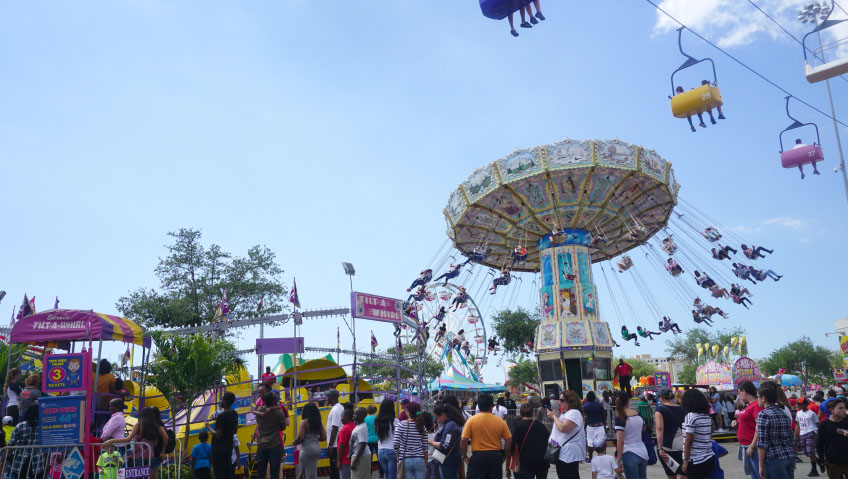Defined as a competitive exposition featuring agricultural products and animals, typically with related entertainment and amusements, the local or state fair has inhabited cities and counties around the world for more than 200 years, and the International Association of Fairs & Expos (IAFE) strives to keep the tradition strong.
This volunteer, non-profit organization supports agricultural fairs, shows, exhibitions, and expositions held at the state, provincial, regional, and local levels, and is composed of members of state and provincial fair associations, non-agricultural expositions and festivals, associations, businesses, and individuals who provide related goods and services.
Founded in 1885 with six fairs in its roster, the IAFE, headquartered in Springfield, Missouri since 1980, currently represents more than 1,100 fairs worldwide and more than 900 members from related industries, and has consistently upheld its commitment to the mission of supporting and encouraging the growth and enhancement of agricultural fairs, exhibitions, and expositions.
“The IAFE was created to act as kind of a clearinghouse for fairs to get together to discuss their common problems, to come up with common standards they can work with to avoid having competing dates with one another—especially state fairs—and come up with policies,” explains President Marla Calico, who also has happens to have access to a vital but long out-of-print book that covers the history of agricultural affairs. Published in 1935, The Agricultural Fair by Wayne Caldwell Neely provides one of the best sources of fair history to this day.
The original fairs started before the United States was even its own country, Calico adds, referencing one fair that still operates in Pennsylvania that was granted a license prior to 1776 to operate as a fall agricultural market. A proliferation of county fairs, especially up and down the eastern seaboard, along with burgeoning state fairs, led to the need for organization.
“There came a time when fairs hadn’t quite found their purpose,” says Calico. “This created a need to come together to make sure that we were taking this industry as a whole—and something that’s a part of our culture—forward.”
This led to annual meetings, conventions and newsletters, a magazine, and then email, e-newsletters, and websites to help keep everyone organized.
“We are very much an organization that throughout its history has existed for connecting and getting information and education out there so our member fairs can do a better job,” says Calico. “Fairs across the globe are part and parcel of their community. We want them to continue to be able to do that for more generations to come.”
To qualify as a member fair—of which there are more than 1,000 today around the globe—there must be an agricultural component at the heart of the organization and activity. For the majority of members, a traditional county or state fair involves a livestock show which may have exhibitors of all species of animals, either strictly limited to kids or open shows for adults. But that isn’t the sole type of agriculture—there are Strawberry Festivals, for example, in both Texas and Florida. Featuring entertainment, activities for youth, competitions (other than agricultural), a carnival, entertainment, and food and beverage options separates fairs from festivals, theme parks, church bazaars, and fundraiser events.
Calico adds that it’s “quite typical” for everyone across the industry to exhibit passion about their roles with agricultural fairs, particularly when it comes to education. “I’ve spent almost my entire adult life in the sector and I love it,” she says. “It’s the type of thing where, if the bug bites you so to speak, it really bites you.”
The organization’s educational efforts involve a printed magazine distributed to its members along with an email production called The News Brief sent out three times a week to 7,000 subscribers, featuring news stories regarding peers in related businesses and items of interest pointing members to new educational opportunities, meetings, or resources. “We rely heavily upon that method of communication to get information out to people, so it’s extremely important,” says Calico. “It’s what I really think is at the heart of what we do.”
Additionally, a foundation called the IAFE Education Foundation, a not-for-profit, was created with the sole purpose of raising money for the organization’s Institute of Fair Management College. The college offers a series of short courses that an individual can take rather at their leisure; once enrolled in the program, participants have six years to collect credits for all courses.
“It’s a basic introduction to some core concepts that everyone involved in fairs today needs to know,” says Calico. “There are a couple of courses on human resources, on finances, programs to remind you of the importance of the agriculture component of a fair, components for carnival, and components on security, safety, and insurance.”
Currently, there are 36 separate courses that must be completed before graduating.
“The success of this has been absolutely unbelievable,” Calico shares. “Today there are probably 300 to 400-plus people who’ve graduated from the program.”
And some positive results have come out of it, she adds, with some great white papers and toolkits that benefit the entire industry. “The addition of this education component has been key to what we’re doing and how we’re continuing to provide what we can to help the fair industry grow and continue to celebrate agricultural shows,” she says.
This is all excellent news for the future of fairs in general, whether in a little village in southwestern Ontario or in the entire state of Iowa. “They exist to serve that community and bring the community together to highlight the very best of the community,” Calico says. “It becomes part of the social fabric, and what’s key is how that fair individually reacts to external circumstances, some beyond their control, and some that they need to adapt to.”
Adapting to changes can include how to build a better website to reach people and develop improved communication to help fairs continue to grow and flourish and keep them relevant in changing times. In the age of electronics, Calico has seen robotics and STEM competitions introduced to several fairs, which introduces an entirely new and diverse generation to the organization.
“I think as long as there are fairs, there is going to be a role for us to play, but we have to be flexible and agile. So that means our team has to be looking at the cutting edge, that we have to have our ear to the ground. We’ve got to say, ‘is there a role for artificial intelligence in the fair industry, and what can we do?’ We have to be proactive.”
One of the organization’s biggest projects at the moment involves addressing the disconnect between today’s consumer and their understanding of food production.
“It’s not universal to every city and village, but we have people almost everywhere who think that milk comes from a grocery store and they don’t even know it comes from a cow,” says Calico. “They think it comes from an almond tree. We have people who will do everything in their power to help stop production agriculture. There are people who believe so strongly that animals should not be utilized in any sense of the word that they’re going to determine what you eat.”
With strong financial support from a number of its members, the association recently completed a consumer research study to find out what people know about their food, who they trust for information about their food, and what opportunities and obligations there are for fairs to fill that gap.
Another critical role the association has to play in regard to the health, financial stability, and future of its members is in mobile amusements and carnivals. “What most people don’t know is that the number of operating mobile amusement companies in the United States alone has dropped by 50 percent in the last 10 years,” says Calico. “But there hasn’t been a commensurate drop of 50 percent of the number of fairs; that number has remained steady. So that means that fewer carnivals are trying to play the same number of fairs. Some small fairs, particularly in rural areas, can no longer get a carnival to operate. They don’t exist.”
One of the reasons for this comes down to the lifestyle of being out on the road for much of the year. “We’re seeing in what had been multi-generational family operations—particularly after the pandemic—that the next generation is saying they don’t want to work that way and take those risks. They want something different for their family.”
State regulations also play a role. Many states have created a prevailing wage for workers when bringing in a carnival, so no matter who is hired, whether it’s a foreign worker with an HTB or a local worker, state minimum wages no longer apply.
“Some states have also created an onerous system of inspection—not just one inspection, but an inspection and a fee every single time you set up,” says Calico. “And then there is the cost of doing business with carnivals operating on diesel fuel with prices that have stabilized at extraordinarily high rates. There’s also insurance, the cost of a new ride, and a carnival has to stay competitive just like any other business, by bringing new offerings to the table.”
Those new offerings are hard to come by, as Calico believes there are no longer any manufacturers of rides in the United States; rides can only be purchased primarily from Europe.
“Those things make it very, very difficult to continue in that particular business,” she says. “That core agricultural piece is at the heart of what you do, but if you think about the business, agriculture is a loss leader. You’ve got to have it front and center, but agriculture competitions in and of themselves don’t pay the way; you need to have other revenue. Consequently, that’s why fairs have entertainment.”
That’s also why they lease space to food vendors and food trucks, why they have an admission charge, and why they work with carnivals—so there’s a funding stream to support that core mission of agriculture. “You can see how that goes hand-in-hand,” says Calico. “For the fairs to survive, the carnivals have to survive as well.”
Despite these ongoing challenges, however, Calico has only positive things to say about her time spent in the business.
“Sometimes I think I have the greatest job in the world because I get to go out and visit our members where they are, see their operations, celebrate with them, and help them. So I think it’s a pretty cool job!”
And it’s a job she’s striving to keep going for many years to come. “Almost every year someone from the media will say, ‘why are fairs still going on? Are they actually still relevant?’ And the answer is yes,” says Calico. “Do fairs look different than they did 200 years ago? To a certain extent, yes. They sometimes look wildly different, but still, the core of a county fair state fair or regional fair is about bringing people together.”






